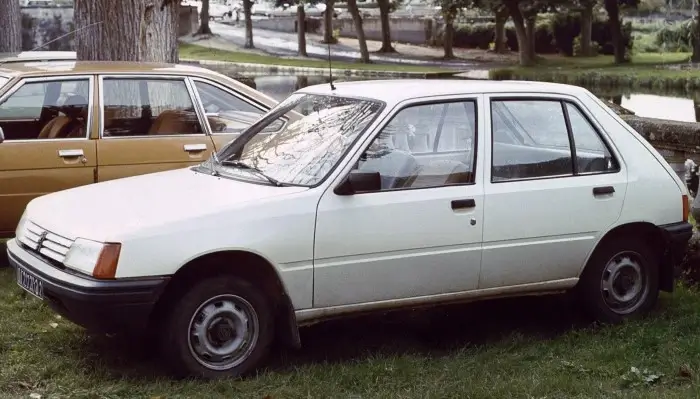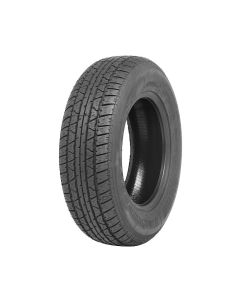Peugeot 205 Tyres

Peugeot 205 White
Peugeot 205 1983–1999
Peugeot 205 1983–1999
- All 1.0L and 1.1L 205s and the 1.8L XLD and GLD 205s fitted 145R 13 tyres. We recommend the 145HR13 PIRELLI CINTURATO ™; CA67 as the best tyre in this size.
- The ideal innertube for 145 R13 tyres is the Michelin 13D.
- Some Peugeot 205's find themselves on 155 R13 Tires due to the scarcity of 145R13 options or a desire for a wider tire profile. When considering the 155R13 size, the 155R13 PIRELLI CINTURATO CA67 stands out as an exceptional choice.
- Longstone recommends you fit the Michelin 13D innertube when using 155R13 tyres.
- 1.4L models and 1.6 Automatic models, as well as the 205 D Turbo fitted 165/70 - 13 tyres.
Peugeot 205 CTi and GTi Tyres
- The 205 1.6L GTi, 1.6L CTi, and 1.9L CTi fitted 185/60 R 14 Pirelli P600 or Michelin MXV. The tyre we recommend in this size is the 185/60 VR 14 Michelin Pilot Exalto PE2. These tyres are perfect for road use and competition use thanks to their rubber compound derived from competition spec, giving them an amazing grip on both straights and corners.
- The 1.9L GTi 205 fitted 185/55 R 15 tyres. The tyre that we recommend in this size is the 185/55 R 15 Michelin Pilot Exalto PE2.
- Tyres with a profile below 70% (e.g 185/60 VR 14 Michelin Pilot Exalto PE2) should not fit innertubes.

Peugeot 205 Carlos Reutemann Driven in 1985
Peugeot 205 Rallye Tyres
- The Peugeot 205 Rallye fitted 165/70 R 13 tyres; unfortunately, no classic tyres manufacturers currently make a tyre in this size.
If your Peugeot 205 is not listed, don't panic! Please give us a call on: +44 (0) 1302 711 123 or Email: info@longstonetyres.co.uk

Peugeot 205 Carlos Reutemann Driven in 1985
If your Peugeot 205 is not listed, don't panic! Please give us a call on: +44 (0) 1302 711 123 or Email: info@longstonetyres.co.uk
Peugeot 205 Tyre Pressures
| Model | Standard: Front (Psi) | Standard: Rear (Psi) | Full Load: Front (Psi) | Full Load: Rear (Psi) |
|---|---|---|---|---|
| 1.0 models | 28 | 30 | 29 | 32 |
| 1.1 models | 28 | 30 | 29 | 32 |
| 1.4 models | 26 | 29 | 33 | 33 |
| 1.6 Auto models | 26 | 29 | 33 | 33 |
| 1.6 GTi and CTi | 28 | 29 | 28 | 29 |
| 1.9 GTi | 29 | 29 | 29 | 29 |
| D Turbo | 29 | 29 | 29 | 29 |
If your Peugeot 205 is not listed, don't panic! Please give us a call on:
+44 (0) 1302 711 123
or
Email: info@longstonetyres.co.uk
History of the Peugeot 205GTi

Peugeot 205 Rallye
The Peugeot 205 was conceptualized as supermini cars were becoming more and more popular, especially in Europe. This popularity uptick and the idea of the Peugeot 205 coincided with Peugeot's acquisition of Simca and Rootes Group in 1978, two key manufacturers of small cars in Europe, namely the Simca 1100 and the Hillman Imp. The acquisition of the formerly Chrysler-owned European manufacturers would allow Peugeot to have access to a group of people who had knowledge and experience of building smaller cars, which was more of an unknown territory for Peugeot due to Peugeot typically being a producer of large saloon cars such as the 304 and 504.
The 205 hit the market on the 24th of February 1983, but the UK would wait until September that year to receive a right-hand drive version. The 205 enjoyed near-instant success, in its first year being runner-up for the European Car of the Year award, during a year or so of incredible competitors emerging, such as the 2nd generation Fiesta, Austin Metro, and Volkswagen Polo MK2.
The construction of the 205 featured a PSA X petrol engine until 1987 which is when they were replaced with the PSA XU and TU engine, both engines had carburettor and fuel-injection models.

1983 peugeot 205
The diesel models fitted the PSA XUD engine used in the Citroen BX. These engines either had a displacement of 1769cc or 1905cc, these diesel engines were so petrol engine-like that they were favoured by many due to the diesel models having the performance of a petrol car with the economy of a diesel car.
The exterior styling of the 205 remained virtually the same throughout its 15-year production run, however, the interior received a few key changes in 1990 to keep up with competitors who had received styling updates in their new generations. Pininfarina styled the cabriolet model of the 205, the other models, however, were not.
The 1.6 GTi was launched in 1984, featuring PSA's XU5J engine, a beefed-up front and rear, larger wheels with wheel arches adapted to fit them, a drop-linked anti-roll bar, and a lower, redesigned suspension. The 205 GTi was a huge success for Peugeot, it is a benchmark car for Peugeot and other hot-hatches as they still try to match its popularity and performance.
The GTi's success brought about another variant of the 205, the 205 Rallye, a more economical version of the 205 GTi. the Rallye was made lighter and cheaper by removing many luxury items such as the soundproofing and the less important electrical systems. The lower weight alongside the performance equipment made it another powerful and popular hot-hatch in the 205 line-ups, selling over 30,000 units.
The Peugeot 205 also produced a group B rally car, the 205 Turbo 16. The Turbo 16 was an all-wheel drive with a modified XU engine that featured a 16-valve head which was moved to the rear of the car. This rear-mid engine 4WD rally car was completely different to the normal specifications of the 205, even the few road-legal models kept the layout and drivetrain of the rally-spec 205s, however, the power was halved. The 205 Turbo 16 and its later Evolution 2 model would go on to claim 16 WRC victories.
The 205 GTi has formed a strong legacy, it's one of Peugeot's most successful cars, making a brilliant economic hatchback with a performance model that is still used as a basis for cars in production today, and to top it all off, a Rally spec variation that was a huge success for the company. The 205 enjoyed a 15-year production run from 1983 to 1998 that pushed Peugeot to new heights. The former Peugeot that was a Saloon manufacturing giant had now branched out to a new market and became a much larger competitor in the European car industry.




















